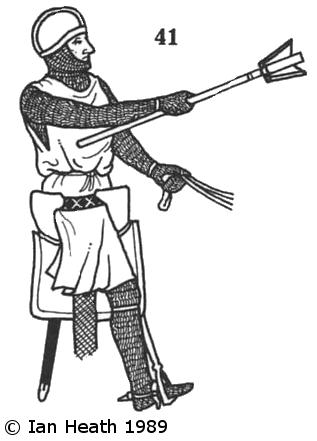 41. SERGEANT-AT-ARMS, 13th CENTURY
41. SERGEANT-AT-ARMS, 13th CENTURYServientes armorum (sergeants-at-arms, sometimes referred to in contemporary sources as serjeants à maces) were first raised by Philippe II Augustus of France in 1191, during the Third Crusade, as a bodyguard against the Assassins. There were never many of them (Philippe IV the Fair set their number at 30 in 1285) and they were generally employed in the role of mounted aides-de-camp, though they could also be found fighting alongside the rest of the army as part of the royal familia - Philippe II's, for example, did sterling work guarding the bridge at Bouvines in 1214. During the 13th century most European kings likewise established bodies of sergeants-at-arms.
They customarily carried a mace bearing the royal arms as a symbol of office, these maces being recorded in the 14th century as decorated in silver with the arms enamelled on. By the reign of Philippe III (1270-85) their armament also included a crossbow, though this may have been part of their equipment at a considerably earlier date; certainly the bodyguard of 24 sergeants-at-arms established by Richard I of England in imitation of Philippe II's guards each carried a crossbow as well as sword and mace even in 1191. A lance, and possibly a shield, were also carried in battle by the 14th century. The particular figure depicted here, from a ms. of c. 1300, represents a sergeant-at-arms at the time of Louis IX. The original picture shows 3 such figures, their surcoats dark blue, red, and turquoise, but carrying no heraldic device (see note to figure 6).
[Based on the Chroniques de France ou de St Denis]
